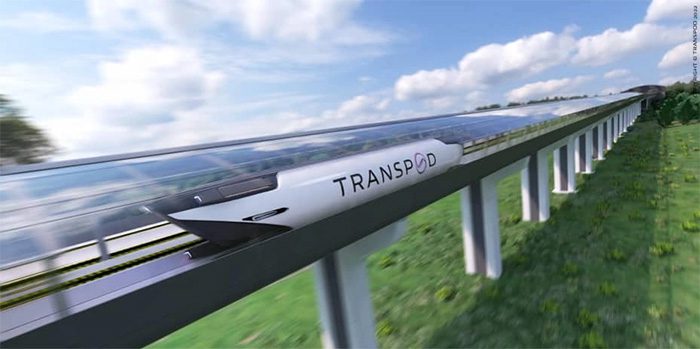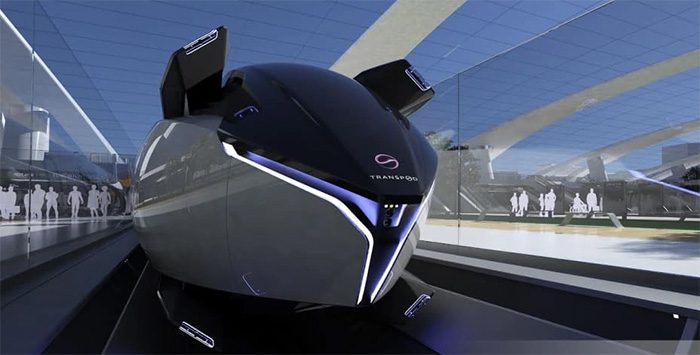A Canadian company aims to join the race for a transportation solution that minimizes carbon emissions, travel time, and ticket prices compared to existing modes of transport.
TransPod is a startup developing the world’s leading ultra-high-speed ground transportation system (TransPod Line). Based in Toronto, Canada, the company recently announced plans for “FluxJet,” an all-electric vehicle described as a “hybrid between an airplane and a train.” The project is currently in the conceptual stage, featuring a 24.9-meter-long magnetic levitation train that can carry passengers at speeds of approximately 997.79 km/h.
This speed surpasses that of commercial airplanes and is nearly three times faster than most current high-speed trains. Because it operates on electricity, the FluxJet produces zero carbon emissions. The company states that the FluxJet will utilize “contactless power transmission”, drawing electricity from the existing power grid through magnetic fields. The aerodynamic design of the aircraft-train hybrid is expected to reduce friction during travel.
The FluxJet will operate on the TransPod Line, a transportation system with stations located at key sites and major cities. The company confidently asserts that this will redefine the transportation of goods and passengers and transform the way people live and travel.
In July, TransPod released a video showcasing the design process of the FluxJet, including an overview of how the technology works and animations illustrating what the final version will look like.
TransPod claims that passenger fares on the FluxJet will be 44% cheaper than airline tickets. In the project’s initial phase, the company plans to build a nearly 321.8 km/h vacuum tube network connecting the Canadian cities of Edmonton and Calgary.
According to this plan, a train will depart every 2 minutes to meet the travel demands of the public. Each train will carry a maximum of 54 passengers and 10 tons of cargo per trip. The company estimates that the journey of 281.6 km between the two cities will take only 45 minutes.

This is an all-electric vehicle described as a hybrid between an airplane and a train. (Photo: TransPod).
An $18 Billion Commitment
That’s good news. However, the bad news is that even with optimism, this transportation system will take many years to build and will cost billions of dollars.
In March, TransPod raised $550 million in funding from UK investors Broughton Capital Group and the state-owned China-East Resources Import & Export company. This funding will support ongoing research and development activities, along with plans to construct a test track and conduct speed tests from 2023 to 2027.
The company stated that it aims to begin construction of its intercity FluxJet line by 2027. TransPod also indicated that the project will ultimately cost $18 billion. This means they will need to raise a significant amount of additional funds moving forward, whether from private investors, government grants, or both.

The FluxJet will operate on the TransPod Line. (Photo: TransPod).
Surpassing billionaires Elon Musk and Richard Branson, this Canadian company seeks to create the most optimal mode of transportation.
TransPod claims that this investment will be well worth it. The company predicts that building the FluxJet system will create “up to 140,000 jobs” and add $19.2 billion to the region’s gross domestic product (GDP). TransPod stated that the system will reduce carbon dioxide emissions by 636,000 tons annually once construction is completed.
Upon the launch of FluxJet, Mr. Sebastien Gendron, co-founder and CEO of TransPod, remarked: “All the hard work over the past few years has led to this pivotal moment, where conversations are becoming reality.”
Mr. Ryan Janzen, co-founder and CTO of TransPod, stated: “This milestone is a significant step forward. FluxJet is the combination of scientific research, industrial development, and massive infrastructure to meet passenger demands and reduce our reliance on jet planes and fossil fuel highways.”
Mr. Yung Wu, CEO of MaRS Discovery District, commented: “TransPod completely changes the game in high-speed, zero-emission passenger and freight transport between major cities.”
“It’s time for our policymakers, investors, and operators to act boldly to support the commercialization of Canadian initiatives like TransPod, to win in the trillion-dollar global innovation economy.”
High-Speed Train Projects by Billionaires
Meanwhile, billionaire Richard Branson’s Virgin Hyperloop One previously announced plans for a similar high-speed train system aimed at transporting passengers at speeds of up to 1223 km/h.
In testing, Virgin’s prototypes have so far reached speeds of around 386 km/h. Recently, the company laid off 111 employees and shifted its focus to freight transport rather than passenger travel.
Similarly, billionaire Elon Musk’s The Boring Company has been digging underground tunnels in Los Angeles and Las Vegas for several years, hoping to eventually fill them with a high-speed “hyperloop” transportation system. The electromagnetic levitation train would carry passenger pods at speeds exceeding 965 km/h.
So far, the tunnels have only been used to transport Tesla vehicles at speeds of around 80 km/h. Mr. Musk tweeted in April that he wants to start “full-scale testing” of an electromagnetic levitation train by the end of this year.


















































